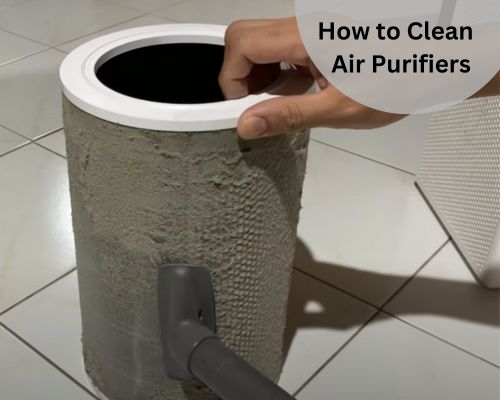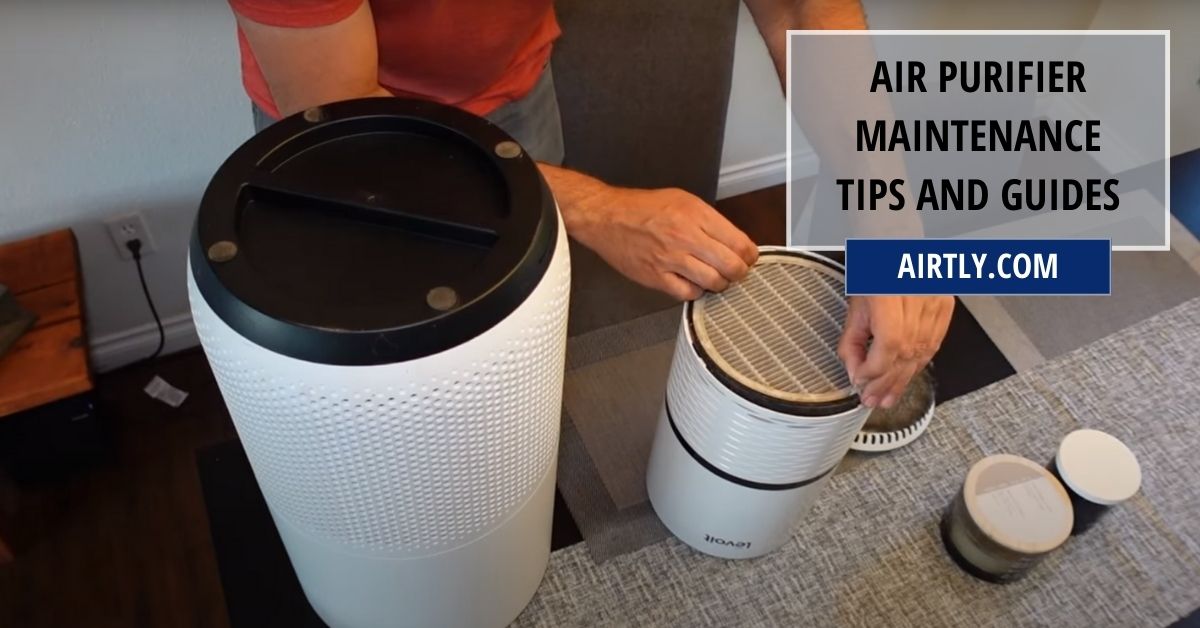Nothing can ensure a healthy and uplifting atmosphere inside your house like an air purifier or air cleaner. And no wonder why they are getting more attention day by day.
But simply buying an air purifier and setting it up won’t get your job done. What you need is a complete list of air purifier maintenance tips and guides. Why?
Proper maintenance of an air purifier is indispensable if you want to get continuous value out of your machine. Maintenance will keep the machine at its peak performance, providing you with the healthiest environment possible for you and your family.
Also, an overlooked, faulty air purifier can do more harm than good in application.
For your convenience, I’ve gathered all of the most important information available on the internet about air purifier maintenance and condensed it into this short and simple guide. Let’s dive in.
How Effective Are Air Purifiers?
Air purifiers have one job, and that is to remove pollutants from the air. Purifiers that are currently popular in the market use some sort of filtration process to clean the air.
Some purifiers don’t directly use a filter for purification. Although these purifiers do a good job of cleaning the air, they’re not much prevalent due to some unavoidable effects they have on the environment.

But the good news is most filter-based purifiers popular in the market nowadays are exceptionally efficient at getting their job done. The other two variants, electrostatic air filters, and ionizers, are comparatively less efficient than filter system purifiers.
Especially purifiers with a HEPA filter can filter out many allergens from the air. This filtration ability makes using an air purifier for eczema treatment a viable option.
How to Clean Different Types of Air Purifiers
Air purifiers’ appearance and working mechanism have evolved quite a bit over time. Let’s take a look at some variants of air purifiers and how to clean them properly.
Ionizer Air Purifiers
These special kinds of air purifiers don’t use a trapping mechanism for the purification process. Instead, they are called air ionizers because they ionize pollutants to make them heavier.
Ionizers are easily cleanable and maintainable. The goal behind this machine’s design was to build a purifier that works without filters because no filter means no frequent cleaning and changing.
Cleaning
But ionizers will still require occasional cleaning. Before attempting to clean them, unplug the machine and discharge it.
To discharge, locate the carbon brush of the ionizer and make a momentary contact between the brush and the ionizer plug.
Discharging is essential as accumulated charges can cause electrical shock. They can also damage the appliance itself.
Once discharged fully, take a mildly damp microfibre cloth and gently wipe the body of the purifier. Then check if the carbon brush is too hard and sticky.
If it is, use warm water and a small amount of soap or detergent to gently wash the dirt off. Otherwise, just cleaning it with a damp cloth should suffice.
However, you should clean the carbon brush at least once a month. Don’t submerge any part of the appliance in the water. Also, don’t rinse it under tap water.

Electrostatic Air Purifiers
These purifiers also use charges to get rid of pollutants, but the difference is that these have filters. Electrostatic air filters are less efficient compared to HEPA filter system purifiers, but their maintenance is comparatively less heckling.
The filter of an electrostatic purifier holds a static charge which gathers pollutants as the air passes through. So before any attempt of cleaning, always discharge the appliance properly.
Cleaning
Although these sorts of purifiers require frequent cleaning, they’re really easy to clean. The filters have a wide opening that makes them easily accessible for casual wiping.
They’re also easily detachable, as all you need to do is slide the filter out. If the filter is too dirty, detach it and wash all the dirt and debris with mild soap water.
When using soap or other chemicals for cleaning the filters, check the manual first to see if they are compatible. Also, before re-attaching the filter, make sure it’s completely dry.
Filtered Air Purifiers
Currently, these air purifiers with layers of filters are considered to be the most effective and environmental-friendly way to keep your home atmosphere pristine.
These purifiers often have 3 distinct layers of filters to properly filter out the pollutants. Let’s see how to keep them clean.
Cleaning
Pre-Filter: A pre-filter will require regular washing. The pre-filter mainly catches large pollutants like removing pet hair from the air. That’s why it’s more rigorous and can be washed with liquid soap.
HEPA Filter: A HEPA filter is weaved tightly with the thinnest fibers so that it can catch the tiniest of pollutants. That’s why it can be quite delicate and is often told not to wash with water.
Read your manual before attempting to clean the HEPA filter. If washable with water, use a diluted liquid soap solution and gently clean the filter.
For not-washable filters, simply wipe them clean with a microfibre cloth.
Carbon Filter: Purifiers can also have an additional carbon filter in the mix. The carbon filter works to keep the air free of toxic chemicals and odors.
Carbon filters aren’t really washable and need to be replaced after a certain period. But you can freshen it up from time to time by keeping it in direct sunlight for a couple of hours.
Additional Cleaning Tips
You should always clean your purifier according to the user manual. But some basic tips apply to almost every unit in the market. Let’s find out.
- You must unplug the purifier before cleaning.
- Clean the area around ionizers often, as it is the most effective in its vicinity.
- Clean the filters of your electrostatic purifier frequently, as the dirtier they’ll get, the lower the filtration efficiency.
- Don’t put your machine on a metal surface, especially if it’s an ionizer or electrostatic purifier.
- Don’t clean the purifier around its operating location.
- You can vacuum the pre-filter but never use a vacuum cleaner on the HEPA or the carbon filter.
- After cleaning, make sure everything on the appliance is bone dry before you plug it back in.
Maintenance Tips for Air Purifiers
No matter what type of air purifier you use, there are some basic dos and don’ts when it comes to maintenance.
- Utilize the Owner Manual:
Follow the instruction manual strictly when handling your purifier. This advice is actually applicable to any sort of machine you wish to operate.
Air purifiers vary a lot between brands. And different brands offer unlike technologies and features and require them to be maintained differently.
The manual provides the most useful information regarding the best utilization of your machine. It also discusses issues you might face, their solutions and answers to common queries.
- Secure the Area Around the Purifier
If you can make a purifier’s job easier, it’ll work more effectively and last longer. That’s why you must keep the area under the coverage of the purifier as clean as possible.
Clean dust and other observable pollutants regularly yourself. This way, the purifier will remain pressure free and focus on smaller pollutants and allergens.
Don’t put anything heavy on the purifier. This can disrupt the machine’s operation, and such disruption can wear it out slowly but surely.
Also, make sure you’ve placed the purifier in a suitable place. There should be a good amount of room available around the device, and nothing should be blocking its inward and outward air circulation.
- Check the Filters
Air purifiers can have two types of filters – permanent and disposable. Check the condition of the filters every two weeks and wash the permanent filters once every three to six months.
Disposable filters are not meant to be washed. Instead, check them frequently and replace them when necessary.
- Beware of Water and Other Damages
Water is not good for your purifier. So can be a lot more things which should be mentioned in the user manual. Beware of the stuff that has the potential to harm your machine.
Also, never run one that is damaged or has an outmoded filter. A damaged purifier can do more harm than good.
Frequently Asked Questions
- How frequently should we change the filters?
The HEPA filters get dirty very easily. Even if you’re cleaning them regularly, replace your HEPA filter once every three to six months at least. Carbon filters should be replaced once every three months. This replacement schedule depends a lot on the unit and its purifying atmosphere.
- Do you leave the air purifier on 24/7?
Actually, yes. That is the ideal case if you want to keep the atmosphere in the house or room clean all the time. Purifiers need to keep filtering the air continuously because the pollutants are very invasive.
This means if you turn the purifier off, the pollutant level of the atmosphere will rapidly increase back, making the air quality bad again.
Conclusion
Environmental pollution is rapidly increasing day by day, and we need a clean atmosphere in our homes now more than ever. I hope this article contains the most useful air purifier maintenance tips and guides.
A damaged or poorly maintained purifier can cause accidents and air quality degradation. So, always keep your purifier under proper maintenance.
